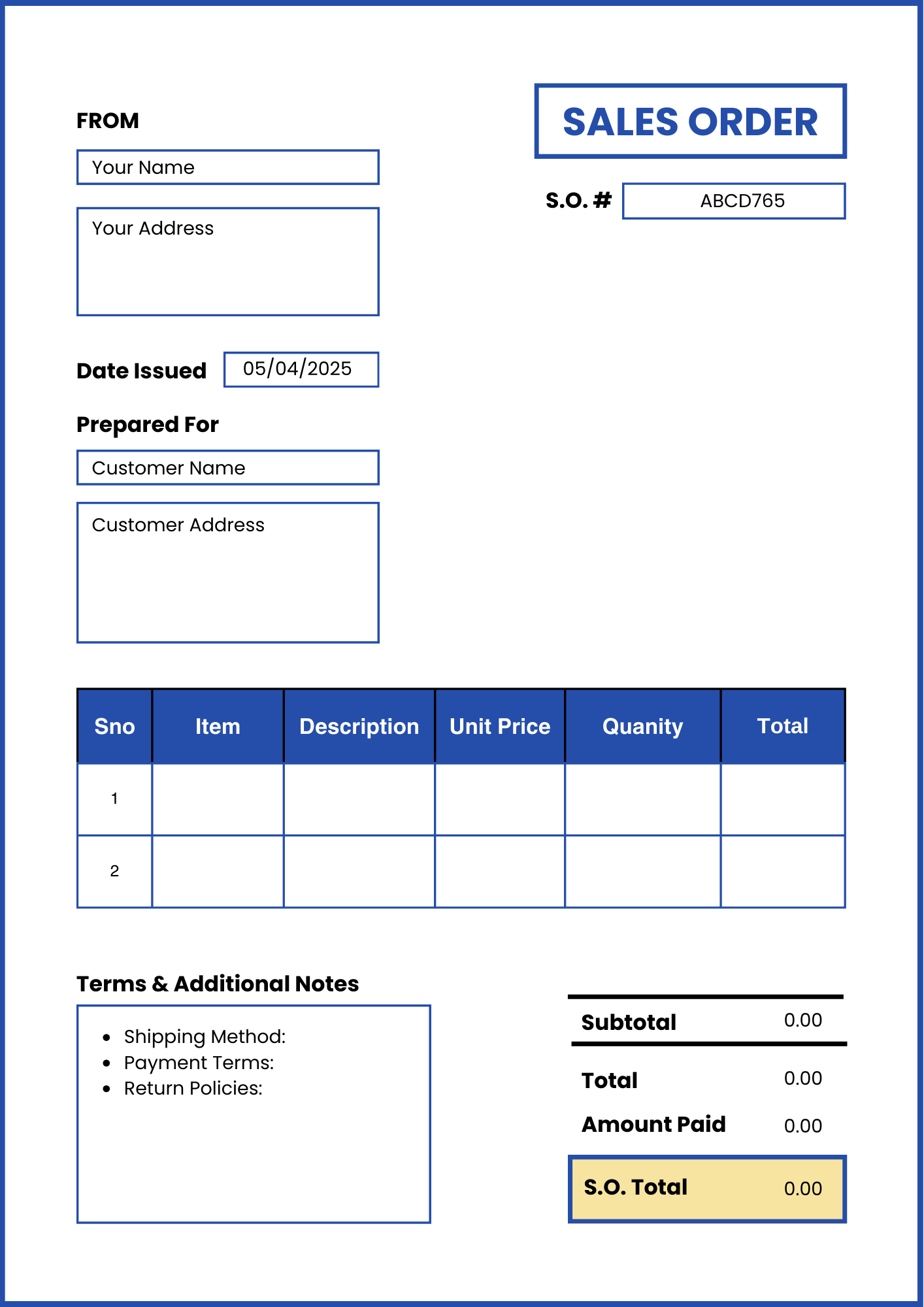Free Sales Order Generator
Create a professional sales order effortlessly! Simply fill out the template below, then download or print your sales order for free.
Create New Sales Order
Creating a professional sales order has never been easier! Follow these simple steps to generate a structured and accurate sales order in minutes.
Step 1: Add Sales Order Details
- Assign a unique Sales Order Number (S.O. #) for easy reference and tracking.
- Select the date of issue to maintain accurate transaction records and establish order timelines.
Step 2: Enter Your Business Details
- In the “From” section, input your business name, address, and contact details to identify the sender of the sales order.
- Ensure accuracy, as these details will be used for record-keeping and communication.
Step 3: Enter Customer Information
- In the “To” section, provide the customer’s name, company, and address to ensure proper order tracking and delivery.
- This helps in identifying the client and ensuring that the sales order reaches the correct recipient.
Step 4: List Products & Pricing
Use the item table to add the products or services being sold.
- Enter a detailed description for each product.
- Specify the unit price and quantity of each item.
- The system will automatically calculate the total amount for each product.
Click the “+” button to add multiple items to the sales order.
Step 5: Add Terms & Additional Notes
- Use the Notes section to include any special instructions, terms, or remarks related to the sales order.
- This is useful for adding return policies, shipping details, or payment terms.
Step 6: Calculate & Review Totals
The system will generate a breakdown of:
- Subtotal: The total cost before taxes and adjustments.
- Total: The amount after adding taxes or additional charges.
- Amount Paid: Any advance payments made by the customer.
- S.O. Total: The final payable amount after all calculations.
Step 7: Preview, Download & Share
- Click “Preview” to review the sales order before finalizing.
- Download the sales order in PDF format or print a copy for records.
- Easily share the sales order via email for instant customer access.
How to Create a Sales Order
A Sales Order is a crucial document in the sales process, confirming a purchase between a buyer and seller. It ensures clarity in product details, pricing, and delivery terms. Follow these steps to create an efficient sales order.
Step 1: Enter Business and Customer Details
- Add your company’s name, address, and contact details.
- Include the customer’s name, shipping/billing address, and contact information.
- Assign a unique sales order number for tracking.
Step 2: Specify Product or Service Information
- List product descriptions, model numbers, or service details.
- Mention unit prices, quantity, and applicable taxes.
- Define any discounts or promotional offers applied.
Step 3: Set Delivery and Payment Terms
- Include estimated delivery date and shipping method.
- Specify payment mode (credit card, bank transfer, etc.).
- Mention payment terms (advance, net 30 days, etc.).
Step 4: Review Terms and Conditions
- Outline refund, exchange, and warranty policies.
- Ensure all legal obligations and contractual agreements are clear.
- Highlight additional charges like shipping, handling, or customs fees.
Step 5: Finalize and Send the Sales Order
- Verify all details for accuracy and compliance.
- Generate the sales order in PDF or digital format.
- Send the document to the customer via email or printed copy.
Requirements for Professional Sales Order
Creating a professional sales order involves including key details that streamline transactions, improve accuracy, and ensure compliance with business policies.
🔹 Company and Client Details – Clearly list seller and buyer names, addresses, and contact information for accurate record-keeping.
🔹 Sales Order Identification – Assign a unique reference number for tracking, invoicing, and order history management.
🔹 Product or Service Breakdown – Provide item descriptions, quantities, unit prices, and any applicable discounts for transparency.
🔹 Payment and Shipping Policies – Define payment terms, accepted methods, delivery charges, and estimated shipping timelines to manage expectations.
🔹 Legal Disclaimers and Conditions – Outline warranty, refund policies, and any special contractual agreements to avoid disputes.
🔹 Authorization and Confirmation – Ensure internal approval before sending the final order via email, PDF, or printed copy for customer acknowledgment.
What to Include in a Sales Order
A sales order is a key document that outlines the details of a transaction, ensuring smooth processing and fulfillment. Below are the essential elements to include for accuracy and efficiency.
✅ Company & Contact Information
- Business name, address, and official contact details.
- Salesperson’s name and direct contact details.
- Buyer’s full name, company name, and billing details.
- Shipping address and recipient’s contact information.
✅ Product & Pricing Breakdown
- List of products or services with detailed descriptions.
- Unit price, quantity, and total cost calculations.
- Discounts, taxes, and any additional charges.
- Final payable amount, ensuring transparency.
- Payment terms, including due dates and accepted methods.
✅ Order Processing & Delivery Details
- Unique order number and issuance date for tracking.
- Processing time and estimated order completion.
- Expected delivery date, shipping method, and tracking options.
- Any applicable contractual terms or warranty coverage.
- Legal agreements, refund policies, and compliance terms.
Sales Order FAQs
How to Process a Sales Order?
Processing a sales order involves verifying customer details, confirming product availability, generating an invoice, approving payment, and scheduling shipment or delivery to fulfill the order efficiently.
Who Prepares a Sales Order?
A sales representative or order management team prepares a sales order, ensuring accurate customer information, product details, pricing, and terms before approval and fulfillment by the logistics or operations department.
What is the Sales Order Life Cycle?
The sales order life cycle includes order creation, approval, inventory check, invoicing, payment processing, order fulfillment, shipping, and customer confirmation for successful transaction completion.
How do you Record a Sales Order?
A sales order is recorded in an order management system or ERP, capturing buyer details, product information, payment terms, and order status for tracking and fulfillment.
What is the Best Sales Methodology?
The best sales methodology depends on business goals but includes consultative selling, value-based selling, solution selling, and inbound sales strategies for higher conversion rates and customer satisfaction.


